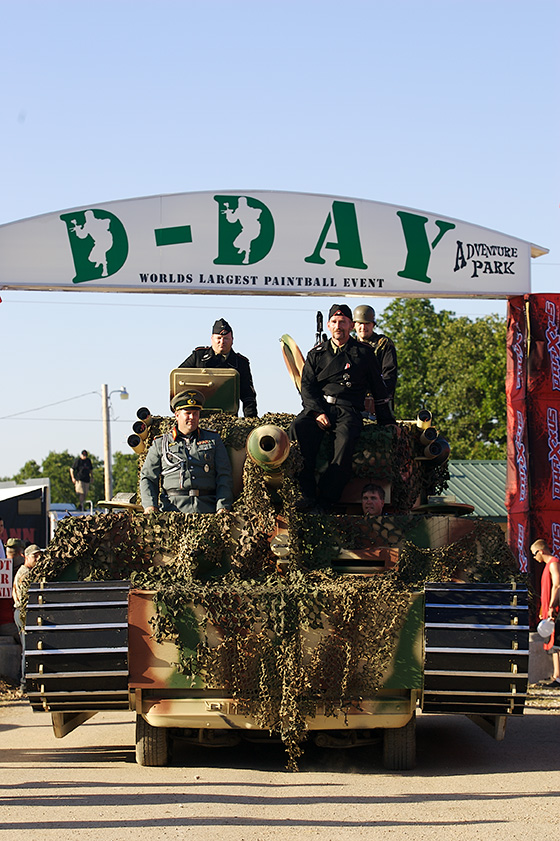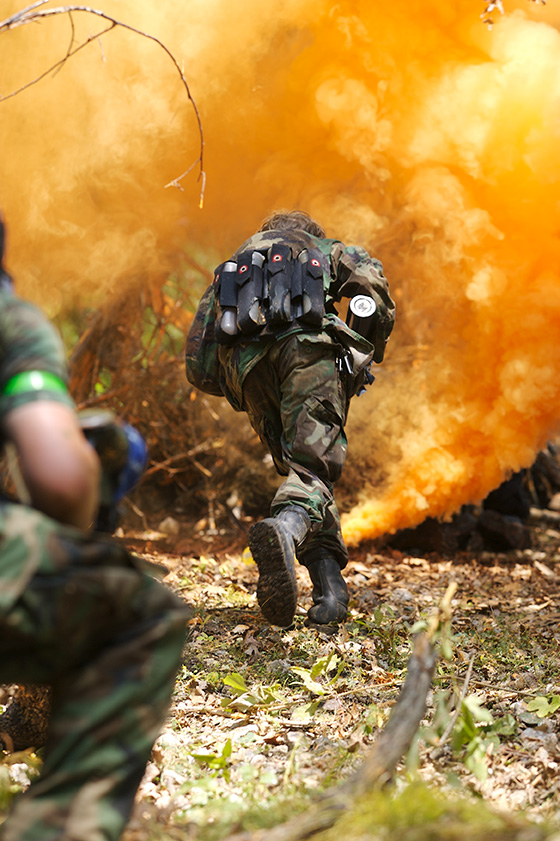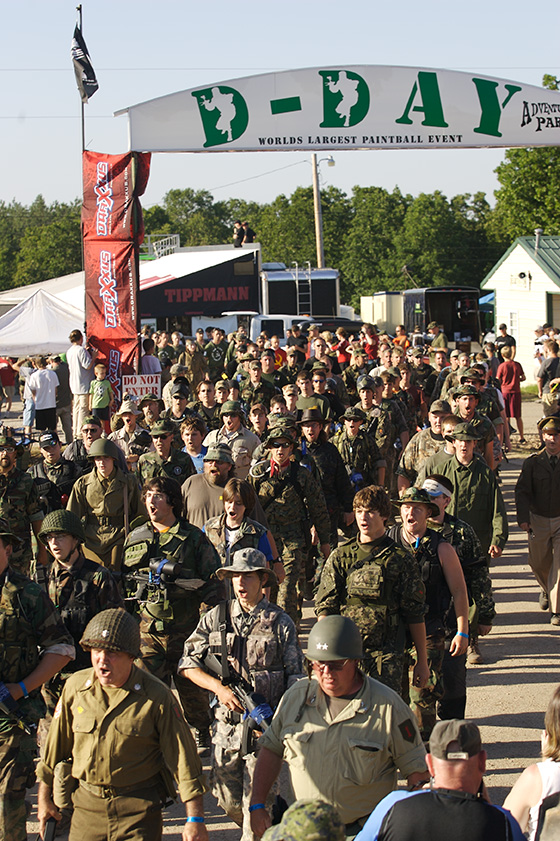

The Allies rolled several tanks and a fighter plane into the valley, and pointed their cannons up at the Germans

Leaves are shredded and twigs broken in a maelstrom of paint as the 1st Infantry Division unleashes a “surprise” on Omaha Beach-hundreds of men and boys storming across the English Channel with angry muzzles pointed towards the German-held palisades. They carry American flags and roar with hundreds of deep throats overcome only by the sound of action. At 0900, more or less, this coordinated attack commences on three beaches: Sword, Omaha, and Utah, scattered around the D-Day Adventure Park fields.
In keeping with history, the beaches are being attacked from landing craft. One is an actual, floating craft dragged across a pond, while the rest are plywood mockups marooned on the Oklahoma dirt. Several hundred Allies were dropped earlier in the morning on the 210-two hundred and ten acres of additional, undeveloped land-and elsewhere around the 710 acre field.















They massed well behind the German lines, and marched towards objectives decided by Supreme Allied Commander “Psycho” and his War Cabinet. The Germans dug in and waited for the first waves to crest against their trenches, ramparts, bunkers, and other fortifications. The attack would come from all sides, and before it’s over, turn everything a lighter shade of orange-this was their Departure Day in Wyandotte, Oklahoma, and 4,019 players were suited up with orange-fill DraXxus paint in their hoppers. The event set the record; the game set a precedent.
Contact!
The first objectives to fall were the towers on Utah Beach, a particularly merciless stretch of land on the northern end of the field. A half-hour’s walk over rocky, dusty, thick terrain from the camping area, most players elected to ride the deuce-and-a-half “Army trucks” or converted school buses that ferried defenders to the farthest edges of the property. When the Germans arrived at Utah, they found a complicated series of trenches topped with long Oklahoma prairie grass. Wooden bunkers were scattered here and there, with two large lookout towers dominating the skyline to the east. The earth sloped downwards markedly, towards three landing craft in the valley.
Earthen ramparts were augmented with concrete walls and obstructions, anti-landing craft crosses, old military vehicles…the sorts of things one may find on a deserted battlefield long after the salvage has been removed. What they didn’t see were seven Hollywood-quality pyrotechnic charges hidden in the grass. Referees kept personnel away from them.
The Allies rolled several tanks and a fighter plane (mounted atop a jeep) into the valley, and pointed their cannons up at the Germans, of whom there were only 96. Right on time the pyro pots popped with thirty-foot flames, smoke plumes, and thunder. Seven exploded in series, starting the game on an epic note that crashed through the valley. Thousands of markers opened up, spewing more than a case a second into the Oklahoma sky.









Hidden away in the shade nearer to the camping area, is the traditional D-Day invasion spot: Omaha Beach. Several hundred German players, more than at Utah but still under staffed, held fast in a series of trenches cut into a steep hillside. A full size concrete pillbox guards a particularly nasty slope, along with thirty yards of fake barbed wire and obstacles. Two shore-to-ship “gun emplacements” guard the summit of Omaha Beach, and each are worth 100 points hourly from 11:00 to 1:00pm.
This tracks with the other primary objectives, as Utah Beach is worth 200 points at 11:00am and “expires” at 12:00pm for another 200, while Sword expires at 11:00am for 200 points. Oklahoma D-Day is a macro-tactical game, where the tactics and maneuvers exhibited at the company level win or lose the game. Thus, an objective scoring system is used: certain critical components of the field, such as villages, bridges, and “beaches” where most of the Allies insert, are valued in points and given a set time by which the Allies need to have captured them. Un-captured objectives are scored in favor of the defending German team.









Sword beach is the oft-neglected front at OK D-Day. The responsibility of the Commonwealth Forces, this beach is hidden away in the woods between Pegasus Bridge and the village of Caen. Shaded, but smaller and less spectacular than the other beaches, it is nonetheless critical to most Allied strategies: with the bulk of their forces inserted into the game via the beaches, they must fight their way through Sword to attack Caen and flank the southern edge of Colleville.
Worth only fifty points at 1100, the fuel dump in Caen is worth another fifty at noon and a hundred at 1300, making it a 200 point objective, all told. Another crucial aspect of this position is its control of two reinsertion points and an air/paint station. Pegasus Bridge, though not a tactical consideration, is in the immediate area and worth fifty points at 1030-the same as Merderet Bridge in the Vierville Valley.
The other early objectives were the “guns of Brecourt Manor,” along the road between Colleville and the Airfield. The game coordinators dropped the Airborne units far west of Colleville, in the trees where they could choose several avenues of approach behind the German lines. They pushed towards the backside of Sword Beach, and didn’t hit Brecourt as strongly as they could have-the points went completely to the Germans, as did the fifty for Pegasus Bridge.
“We had (fake) barbed wire, mines, everything,” Ryan Smith said. He watched Sean take out nearly forty players with the Double Trouble, in a desperate bid to slow the combined Airborne juggernaut. “It slowed them down some… We were just supposed to stop them from getting to the beaches fast.” And they succeeded.
By 1100, two hours into the game, the Germans still controlled Sword beach and all 200 points it was worth. Not that the Commonwealth wasn’t trying-the German forces had just been marshaled to protect that beach and its connections to Colleville. But the manpower came from somewhere…


















As the 96 defenders of the quickly-overrun Utah Beach can attest, lack of German defensive numbers was a significant factor this year. Though not as lopsided as several years ago, the hundreds of Allies attacking Utah found less than a hundred defending Germans. “Oh man,” German Field Marshall Wilhelm Bailey exclaimed from his passing command tank, “it’s another numbers game!” When he clarified his statement later, he noted the light forces on Omaha, Sword, Colleville, and elsewhere. Nonessential personnel were pulled from deep emplacements in the desperate minutes leading up to game-on, to plug the gaps left by phantom players.
Where’d the Germans Go?
One group showed up to play speedball on the complementary speedball fields, Bailey said. “I talked to them, and they said ‘it’s cheaper to play speedball here all week than it is to practice anywhere else.’ They were signed up as German, but didn’t play in the game.” Thus, in balancing the teams during pre-registration, the Germans were credited with that many players, and matched with an equal number of Allies who actually showed up Saturday morning.
Other players were scattered between various units, with no hard loyalty to one group. When their front went quiet, rather than waiting for a strategic defense or redeployment, they’d wander off in search of action, and frequently find their way to the parking lot. But why didn’t they show up in such strength at first?
Despite being assigned to units during pre-registration, many of them felt somewhat adrift among the hundreds of tents and thousands of players. When they loaded up for deployment, hardcore groups like the Geisterjaegers stuck together tightly…and others just wandered into random transports. The Allies had the edge in pre-game unit identity and cohesion, and it showed when the buses rolled out on Saturday morning.
Lunchtime?





























By one o’clock, the game was being dominated by motivated, well-marshaled Allied players with a lopsided score of 1,500 to 450. The Allies failed on Sword, but succeeded marvelously on Utah, Omaha, Caen, and in taking Pegasus Bridge an hour after the Germans received the first points for it. While a number of players hopped rides off-field for lunch, most never to return, the vast majority of both teams stayed on the field.
On-field paint sales, via a coupon redemption program, and on-field air fills helped them stay equipped. A number of water buffalos, one in each of the larger reinsertion zones, kept them hydrated. The thirty minutes between reinsertions provided welcome respite after a few hours in the brutal Oklahoma sun. With their goggles off behind the safety netting, players hydrated and traded memories even as the game unfolded yards away.
Then they got back into it, throwing themselves repeatedly at each others’ offensive and defensive lines…and loving it.
More than Saturday
Oklahoma D-Day is more than a one-day scenario: it’s a week-long woodsball extravaganza. Starting on Monday, June 4th, they played paintball-a lot of paintball. In previous years Jeremy Hanna, game coordinator and second in command under D-Day pioneer Dewayne Convirs, watched players sit around for days before the game. Then the game’s command staff had a golden idea. “We’ve had thousands of players sitting around with nothing to do,” he said, “so, why not play paintball? That’s why everyone’s here!” Thus, the “mini-scenarios” were born.
They started with several dozen players early in the week, and had grown to 600 players-in one somewhat formal mid-week game-by Wednesday. Special skills and tactics classes were held, including a qualification course for “Special Forces” players that Wetworkz from Kansas City, MO, facilitated. They’ve built an impressive course with intimidating obstacles for a legendary experience-the closest you can come to Boot Camp training without signing a contract or losing your hair.
Christopher Larkin of Shepherd One-a teambuilding and tactical gaming company-conducted a Small Unit Tactical Leadership (SUTL) Course for Allied commanders. No Germans were invited, though “that would have been cool with me,” he said. It was one of the Allies’ “secret weapons” this year.
A year’s preparations came down to Saturday, June 9th.
Tied Up
This was the tenth anniversary of OK D-Day, as in 1997 field owner Dewayne Convirs held the first one in honor of his grandfather, real D-Day veteran Enos Armstrong. A fair number of people turned out, and since about 2001, D-Day has been setting world records for attendance and duration of a single woodsball event.
And over those years, the Germans have won a few games, and the Allies have won a few games…this year brought the rivalry up to a tie, with five anachronisms and five historically accurate conclusions. The Allied dominance continued long into the afternoon, with the Germans simply unable to keep up this year.
When the scores were announced Saturday night, it was to a crowd of only a few hundred-everyone else was asleep in their tents, their cars, or stretched out on the grass where they’d collapsed from the heat and effort. Word spread, stirring the Allies and deflating the Germans, setting the stage for a solid year of planning by each command staff.
They’ll use the forums again, and in person recruiting; they’ll meet at Woodland Warriors events (promoted by Wilhelm Bailey) and Fledgling Scenarios games (promoted by former Allied Commander Jim Helton). They’ll build more tanks, repaint their old ones, and get second jobs to afford their paintballs.
And in June 2008, you can meet them in the hills of Oklahoma, on your own personal D-Day.